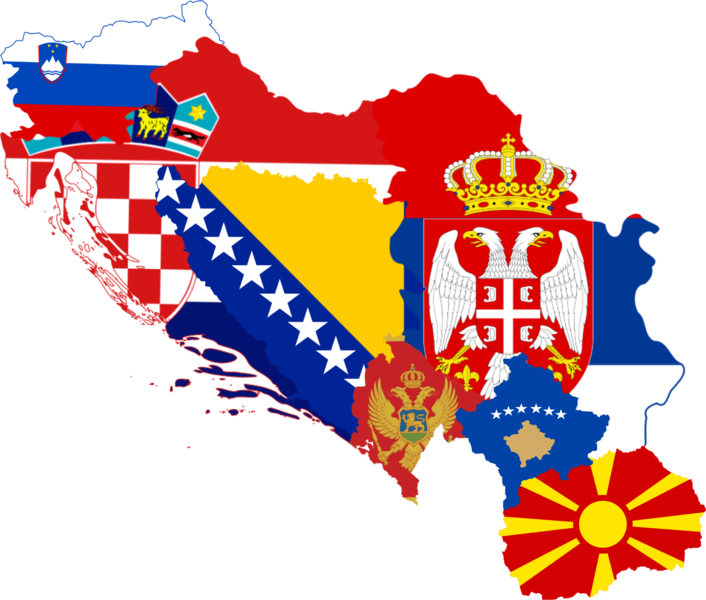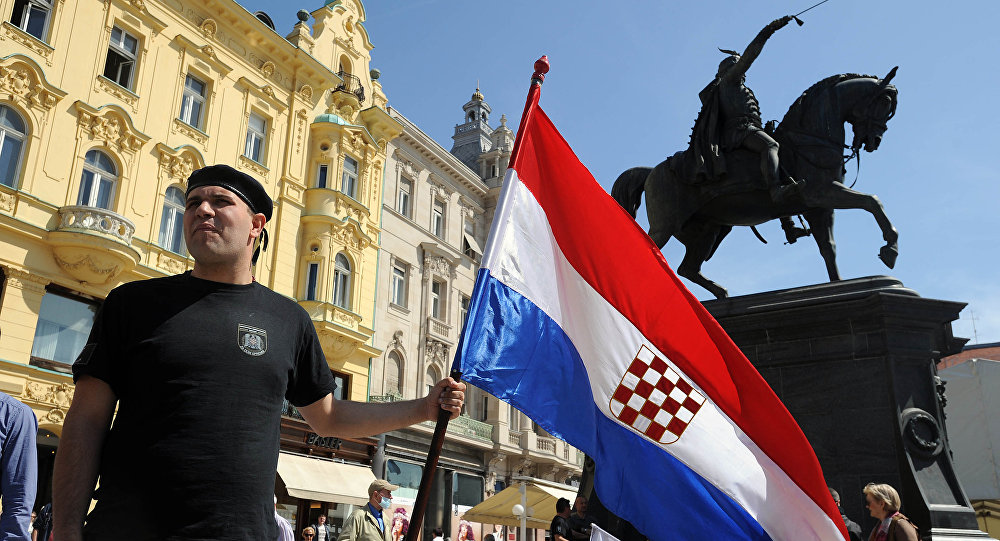
Saudi Arab Islamist beheading Serbs in Bosnia in 1992
Views: 8485
More than 20 years after the Srebrenica massacre, Bosnian Serb General Ratko Mladić was found guilty of war crimes by the International Criminal Tribunal for the former Yugoslavia this past November.
Along with Mladić, the ICTY convicted the other so-called “Butcher of Bosnia”, the Bosnian Serb and former Republika Sprska leader Radovan Karadžić in 2016. Meanwhile, it fully exonerated the Bosnian Muslim army commander Naser Orić of similar charges which outraged the people of Serbia. Yet, it was the same court that posthumously exonerated former Serbian President Slobodan Milošević in 2016. If you weren’t aware of the latter, it’s because it was not widely reported in Western media. Milošević is still generally viewed to be the central villain of the entire conflict even though the charges against him didn’t hold up, but not until a decade after he died of heart failure while on trial in the Hague.
The ICTY in its ruling stated “there was no sufficient evidence presented in this case to find that Slobodan Milošević agreed with the common plan to create territories ethnically cleansed of non-Serbs.” The ICTY, established in violation of the UN charter, is itself viewed to be an arm of NATO and biased against the Serbs but even it seems to have determined that any alleged war crimes and ethnic cleansing by the Bosnian Serbs was strictly a Karadžić-Mladić affair and not part of a chain of command leading to Milošević.
This is not what was presented by NATO and its media surrogates at the time which was that the Bosnian Serbs were acting under direct orders from Belgrade. The narrative was that Milošević’s policies and the Serbian government shared as much of the blame, while the reality is that an extremely complex conflict was simplified into a heroes and villains story in order to sell military intervention to the public. Not only were atrocities committed on all sides in the Yugoslav wars, but the NATO powers sided with right-wing nationalists in Bosnia and Croatia and extremist separatists in Kosovo against the Serbs in order to ensure their own geopolitical interests in the breakup of Yugoslavia. In fact, the entire foreign policy of the west toward Yugoslavia facilitated the very problems it used military intervention to ‘solve.’
During the Bosnian war (1992–1995), war crimes by the Bosnian Serbs were given widespread attention while those committed by the Bosnian Muslims were given little to none. The Bosnian Muslim army was provided CIA arms and training that is well documented. The hidden connection between Bosnian Muslim militants and international terrorism is revealed in the documentary Sarajevo Ricochet, where an investigation discovers that Bosnian Muslim militias, composed of mujahideen rebranded as freedom fighters, received smuggled arms through phony relief agencies connected to Saudi Arabia and the members of al Qaeda who participated in both the 1993 WTC bombing and Osama bin Laden himself. Also linked financially to the front humanitarian organization (known as Third World Relief Agency) was Bosnia and Herzegovina’s Defense Minister, Hasan Čengić. Bosnia became a training ground for global jihad and the army enjoyed support from foreign volunteers from various Muslim countries in mujahideen fighters that committed executions, beheadings and torture of captured Serbs.
It was the infamous massacre of Bosnian Muslims in the village of Srebrenica in 1995 which thrust NATO’s military involvement into the conflict. Undoubtedly a war crime, what was disputed was whether it constituted an act of genocide since the victims were almost exclusively several thousand Muslim men and boys at the hands of the Bosnian Serbs. Women and children were specifically separated and evacuated out of the town under Mladić’s orders just prior to the killings. The possibility that the carnage in Srebrenica could have been the result of revenge executions in retaliation for the widespread terrorism committed against dozens of Bosnian Serb towns by the Bosnian Muslim army for years under the warlord Naser Orić was never explored. Some of the well documented acts by Orić’s forces included executions, beheadings, eye gouging and even disembowling Serbs and the victims included many women and children.
What took place in Srebrenica was certainly a horrific crime, but it could only be seen as unprovoked and not the result of grudge killings if removed from the context of the dozens of raids of Serb villages neighboring Srebrenica. Orić and his militias had been carrying them out for two years up until that point but this was widely suppressed. Srebrenica was stage managed as an unprovoked atrocity committed by evil villains against pure victims in order to sell the case for military intervention against one side. It has even been since portrayed as an act of genocide when it was one instance of many throughout the entire Yugoslav wars of summary executions. Executions, rapes and torture were committed by all sides. To call it genocide is an insult to the victims of the holocaust in the former Yugoslavia of which the majority were Serbs. There is no doubt Serbs did their share of war crimes and ethnic cleansing in the Yugoslav wars, but NATO and its media stenographers only told part of the story that was fundamentally a civil war and not genocide.
The number of dead in Srebrenica also may have been inflated to 8,000 when its actual number is significantly lower, according to scholars such as Edward S. Herman, Diana Johnstone, John Pilger, Michael Parenti, and former Attorney General and human rights lawyer Ramsey Clark who defended Milošević in the Hague tribunal. Many of the dead could have been those killed in the battle for the town, considering that the victims were virtually all male and Mladić’s forces had evacuated Muslim women and children out of the town. This would not have been the only occasion of inflated numbers of victims for sensationalism during the wars as the media had routinely repeated ad nauseam wildly erroneous statistics such as 100,000 Bosnian Muslim women having been raped by Serbs, an impossible number when the Bosnian Serb army was only 30,000 strong.
Srebrenica also may have been strategically sacrificed to be deliberately defenseless by Bosnian Muslim forces so as to provoke NATO military intervention against the Serbs by crossing U.S. President Bill Clinton’s ‘red line.’ The town of Srebrenica had been a safe zone under the UN peacekeepers which Orić and his forces used to shield themselves in between their attacks on Serb towns and it was not protected in this instance.
In the stunning documentary Srebrenica: A Town Betrayed, a police chief of the town shockingly claims that in a meeting with Bosnia and Herzegovina’s President Alija Izetbegović, Clinton suggested his ‘red line’ was that at least 5,000 Muslim lives would need to be lost in order to justify any NATO air strikes against Serb forces. It would not have been the first time ‘false flags’ may have been used by the Bosnian Muslims. There had been two bombings of markets in Sarajevo, known as the ‘Markale massacres’, that were immediately pinned on the Serbs when much of the evidence gathered and eyewitness accounts suggested they were staged attacks that came from areas held by Bosnian Muslim army forces.
 Alija Izetbegović – President of Bosnia-Herzegovina in the 1990s
Alija Izetbegović – President of Bosnia-Herzegovina in the 1990s
Even accepting the stated number of victims, this amount did not exceed the amount of Serbs killed by the Bosnian Muslims in the villages surrounding Srebrenica which was never demilitarized despite being under Dutch UN peacekeeping forces which Orić took full advantage of. NATO, an organization that was designed as a strictly defensive military alliance during the Cold War, needed a new purpose and was given one in its illegal offensive attack in Operation Deliberate Force against the Bosnian Serbs.
It is impossible to comprehend such a complex conflict without first understanding the history of the Balkans during WW2 and which of the republics had collaborated with the Axis powers during their occupation. In 1939, Mussolini invaded the Kingdom of Albania and annexed it as an Italian protectorate. The axis powers collectively invaded the Kingdom of Yugoslavia two years later, with Serbia under the military occupation of the Wehrmacht while much of the rest of Yugoslavia was absorbed into a puppet regime known as the Independent State of Croatia under the dictator Ante Pavelić.
Bosnia and Herzegovina’s President Alija Izetbegović had himself been a Nazi collaborator during WW2 in his youth when modern day Bosnia and Herzegovina territory was under the Independent State of Croatia. His Islamist organization, the Young Muslims, sided with the 13th Waffen SS Handzar Division against the Yugoslav partisans. The first non-Germanic SS division came under the Independent State of Croatia and among its ranks were more than 18,000 Bosnian Muslims who slaughtered both Serbs, Roma and Jews.
Izetbegović served several years in jail for his support of the Nazi occupation of Croatia after the end of the war under Tito. As a politician, he advocated an Islamic state with strict Sharia law and the Bosnian Muslims fostered a revival of the legacy of the SS Handzar Division he had supported in his youth in order to revive nationalist fervor against the Serbs. An example of this propaganda is the cover of the October 1991 Sarajevo magazine Novi Vox depicting a Bosnian Muslim Nazi SS officer stepping on the severed head of Bosnian Serb/Republika Sprska leader Radovan Karadžić (Republika Sprska was the Serb-majority republic within Bosnia and Herzegovina).
NATO and the pliant western media overlooked entirely the neo-fascism of the Tuđjman government in Croatia as well. Croatian leader Franjo Tuđjman had himself fought for the partisans during WW2 (though some claim he was undercover Ustaše), but under Tito he was jailed for supporting Croatian nationalism. As a politician, he expressed fervent anti-Semitism (“the establishment of Hitler’s new European order can be justified by the need to be rid of the Jews”) and holocaust denial in his autobiography (claiming only 900,000 Jews, not six million were killed).
 The Independent State of Croatia in WWII – Final solution of the Serb Question
The Independent State of Croatia in WWII – Final solution of the Serb Question
Tuđjman expressed affinity for the Independent State of Croatia and its Ustaše terrorist organization which committed genocide against Jews, Gypsys and above all Serbs. His political party, the Croatian Democratic Union (HDZ), resurrected the fascist symbols and iconography of the Ustaše era such as the checkered Croatian flag. Many monuments erected honoring the partisans in Croatia were defaced and destroyed. The HDZ generally promotes a whitewashed revisionist history of the Independent State of Croatia and denial of the crimes committed by the Ustaše which were infamously amongst the most cruel and inhumane in all of WW2. The relationship between the Catholic Church under Pope Pius and Nazi Germany is no secret and this manifested significantly in the predominantly Catholic Croatia where the clergy worked intimately with the Ustaše. Many within the clergy hoped the communist-led partisans would be defeated and the Orthodox Christian majority Serbs would be forcibly converted back to Catholicism. It was after Ante Pavelić was given his papal blessing that the Ustaše began their horrific crimes against Roma Gypsys, Jews and especially Serbs.
In the Yugoslav Wars, the Croatian War (1991–1995) resulted when Serbs within Croatia formed a secessionist republic of their own, the Republic of Serbian Krajina, that wished to merge with Republika Sprska (the Serb majority republic within Bosnia-Herzegovina) and the Federal of Republic of Yugoslavia which was jointly formed by Serbia and Montenegro after Slovenia, Croatia, and Bosnia-Herzegovina seceded. Considering the history of Yugoslavia and that more than a third of Croatia is Serbian, their desire for autonomy from a Croatian nationalist regime is understandable. Tuđjman openly spoke of plans for a ‘Greater Croatia’ and Serbs did not have a short memory of their suffering at the hands of intolerant Croatian nationalists during the holocaust. Tuđjman made ethnic cleansing of Serbs an official policy and oversaw the expulsion of more than a quarter of a million Serbs from Krajina with many raped and executed but the media only covered any such crimes when they were done by Serbs.
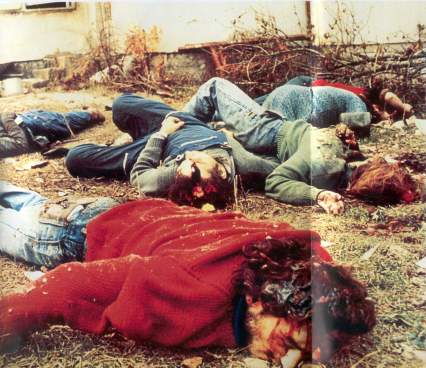 The Independent State of Croatia 2.0 in the 1990s – Final solution of the Serb Question
The Independent State of Croatia 2.0 in the 1990s – Final solution of the Serb Question
In the later conflict, the Kosovo Liberation Army, also armed and trained by the CIA, was similarly rebranded to serve the anti-Serb storyline. The KLA’s publicly declared aim of an ethnically pure Albanian state through secession from Serbia was also traceable back to the Axis powers in WWII with the Italian fascist occupation of Albania and its annexation of the Kosovo province. The KLA’s stated desire to establish a ‘Greater Albania’ was a resurrection and territorial replica of the Greater Albania promised to the Kosovar Albanians by Mussolini which included part of Greece and Macedonia.
The same 13th Waffen Mountain Division of the SS Handzar in the Independent State of Croatia also included nearly 1,000 Albanians. Its central membership later formed the 21st Waffen division of the SS Skanderbeg (1st Albanian). The KLA’s logo of Albania’s traditional double-eagle emblem originates from the version used first in the flag of the Kingdom of Albania (1928–1939) which was a client state of fascist Italy prior to their invasion and was subsequently used by Greater Albania (1939–1943) and every republic since. The KLA separation movement was in its character a Nazi movement and they were followers of an inherently fascist project.
Like the Bosnian Muslims, the vast majority of Kosovar Albanians are Sunni Muslim. The KLA received support from volunteers from Western Europe that were members of radical Sunni groups allied to Osama bin Laden and Ayman al-Zawahiri. In fact, some members of the KLA were even trained in bin Laden’s camps but the organization was removed as a listed terrorist group despite these ties. The KLA committed many grisly beheadings of Serbs just as the Bosnian Muslims had done. Both may have gotten inspiration for this practice from the Ustaše which had been known for beheadings during WW2. The KLA not only received its funding from foreign backers but from well documented mafia criminal enterprise which included drug smuggling (especially the heroin trade) and even the selling of the organs of Serb victims on the black market.
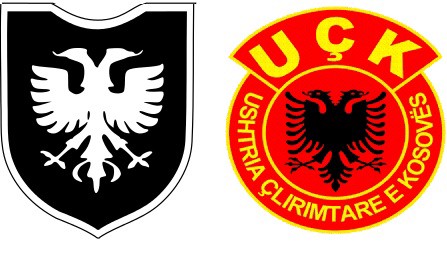 An amblem of the 21 SS Skanderbeg (Kosovo Albanian) Division in WWII (left) and an amblem of (Albanian) Kosovo Liberation Army in the 1990s (right)
An amblem of the 21 SS Skanderbeg (Kosovo Albanian) Division in WWII (left) and an amblem of (Albanian) Kosovo Liberation Army in the 1990s (right)
The Council of Europe published a report in 2016 that detailed accusations of human organ trafficking against the KLA leader and now current President of Kosovo, Hashim Thaçi, who has in years since donated to the Clinton Foundation and a statue honoring Bill Clinton has also since been erected in Kosovo. The brutality of the KLA’s terrorism and ethnic cleansing of Serbs can be seen in the documentary Stolen Kosovo. There were certainly terrible acts committed against Kosovar Albanians by the Serbs, but many more committed by the KLA against them as well as the significant amount of ethnic Albanians who did not support them. Under Tito, Kosovo had been overwhelming popular for ethnic Albanians and many from neighboring Albania under Enver Hoxha crossed the border into Yugoslavia to live there.
The Yugoslav wars had its own refugee crisis but it is well documented that the flow of refugees from Kosovo dramatically increased once the 78 days of NATO militarism struck in 1999. NATO attacked a UN member in Yugoslavia, which had not attacked any of its neighbors, in clear violation of the UN charter and its own declared purpose as a collective and mutual defense alliance when any of its agreed parties came under attack. The bombing itself contributed more to the refugee crisis than its stated ‘justification’ and the three months of brutality during Operation Allied Force in 1999 resulted in more than two thousand civilians killed with thousands more injured at the hands of cluster bombs and B52 missiles. The rest of the population suffered the effects of the depleted uranium from bunker-buster bombs guided by satellite leading to a dramatic increase in cancer, leukemia and birth defects. There were fatal strikes on unintended targets such as a Chinese embassy and another of fleeing Kosovar Albanians which the intervention was supposedly intended to protect from alleged ethnic cleansing by the Serb military. Civilian targets included hospitals, schools, factories, and bridges. NATO even targeted Serbia’s state television station in an airstrike, killing 16 people, which was condemned even by some members of the coalition. All of this can be seen in the documentary Zashto (Why) which focuses on the suffering of the Serbian population.
 Recruitment for the 21 SS Skanderbeg (Kosovo Albanian) Division in WWII
Recruitment for the 21 SS Skanderbeg (Kosovo Albanian) Division in WWII
It was the communist-led Yugoslav partisans who emerged victorious from WW2 under the leadership of Josip Broz (Tito). There had been conflicts between Muslims and Serbs throughout the history of the Balkans going all the way back to the crusades and it was under the Croatian-born Tito and the Federal Socialist Republic of Yugoslavia which strictly forbid right-wing nationalism that for nearly forty years all the different ethnic nationalities and communities of Yugoslavia were successfully united (Yugoslav meaning “Southern Slav”) — Slovenians, Croatians, Serbians, Bosnians, Macedonians, Montenegrins as well as ethnic Albanians, Roma Gypsies and other ethnic and national communities. Yugoslavia under Tito was for most of its history a success story with its market socialism in terms of economic growth and standard of living. However, during this time many of the previous nationalists and fascist collaborators that remained received support from abroad. German and US intelligence agencies aided them during the Cold War as Yugoslavia became a strategic buffer between the US and the Soviet Union after Tito’s fallout with Stalin and its ‘non-aligned’ status.
During the Cold War, the likes of Bosnia, Croatia and Kosovo never underwent full de-Nazification. By the time of Tito’s death and the collapse of the USSR, the doors for empire were opened to encourage nationalist secession in order to break the republic up into eventually seven states. In 1991, the Foreign Operations Appropriation Bill cut off loans, trade and aid to any of the republics that did not declare independence. After Slovenia, Croatia, and Bosnia and Herzegovina seceded, Serbia and Montenegro jointly formed the Federal Republic of Yugoslavia. The myth that the Serbs desired a ‘greater Serbia” was parroted by the media, when most of what they wished to preserve was the remains of Yugoslavia that was being torn apart. Serbs during WW2 had been the foremost victims of the holocaust in Yugoslavia and in WW2 fought alongside the Allies. Serbs had ironically even saved Secretary of State Madeleine Albright’s father Josef Korbel, a Czech diplomat who lived in Belgrade during the holocaust. She decided to repay them with 78 days of bombing resulting in the highest rate of oncological diseases in Europe. The Serbian population rallied around Milošević during the bombing before the U.S. poured money into opposition parties that ousted him the following election. Kosovo, despite declaring its “independence”, has since remained a disputed territory and a neo-colony of the west under NATO military occupation. Following the end of the Cold War, NATO’s uncertain role was redefined with its imperialist utilization in Bosnia and Kosovo and secured further expansion on Russia’s border. Camp Bondsteel in Kosovo is allegedly so large it is one of the few man-made structures visible from outer space.
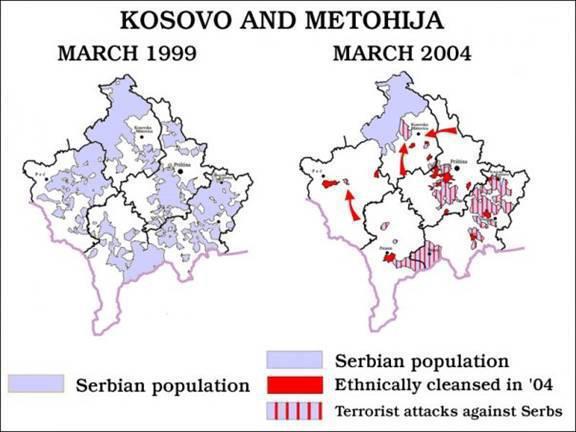 Ethnic cleansing of the Christian Kosovo Serbs by the Muslim Albanians after June 1999
Ethnic cleansing of the Christian Kosovo Serbs by the Muslim Albanians after June 1999
According to scholar Michael Parenti in his crucial book To Kill a Nation: The Attack on Yugoslavia, Milošević and the Serbian government was targeted for being the sole nation in the splintering peninsula that refused to comply fully with the IMF and World Bank mass privatization and the full dismemberment of the former Yugoslavia. None of this is to say Milošević is blameless and without fault in contributing to the nationalism that tore apart the republic. Far from a committed socialist, Milošević was a former banker and Serb nationalist who had ushered in IMF led economic “reforms” in 1988. Many view him as a figure who rose to power as an opportunist by championing the plight of the Serbian minority in Kosovo which only fueled nationalist tensions, but any nationalist rhetoric he espoused paled in comparison to the demagoguery of Tuđjman, Izetbegović, or the KLA. It was the IMF loans that began following Tito’s death which imposed austerity measures that worsened unemployment, collapsed the Communist Party and fueled the nationalism in the decade that followed.
Unlike the other ethnic nationalists in the former Yugoslavia, the Serbs did favor a centralized government and wished to preserve much of the state industry and infrastructure of the republic prior to its fragmentation. Serbia and the Federal Republic of Yugoslavia had a market economy but even this was not enough of a concession for the forces of globalization which according to Parenti desired “an absolute capitalist restoration of Eastern Europe after the fall of Berlin Wall.”
Originally published on 2018-01-08
Author: Max Parry, Brooklyn, NY
Source: The Greanville Post
Origins of images: Facebook, Twitter, Wikimedia, Wikipedia, Flickr, Google, Imageinjection, Public Domain & Pinterest.
Read our Disclaimer/Legal Statement!
Donate to Support Us
We would like to ask you to consider a small donation to help our team keep working. We accept no advertising and rely only on you, our readers, to keep us digging the truth on history, global politics and international relations.
[wpedon id=”4696″ align=”left”]
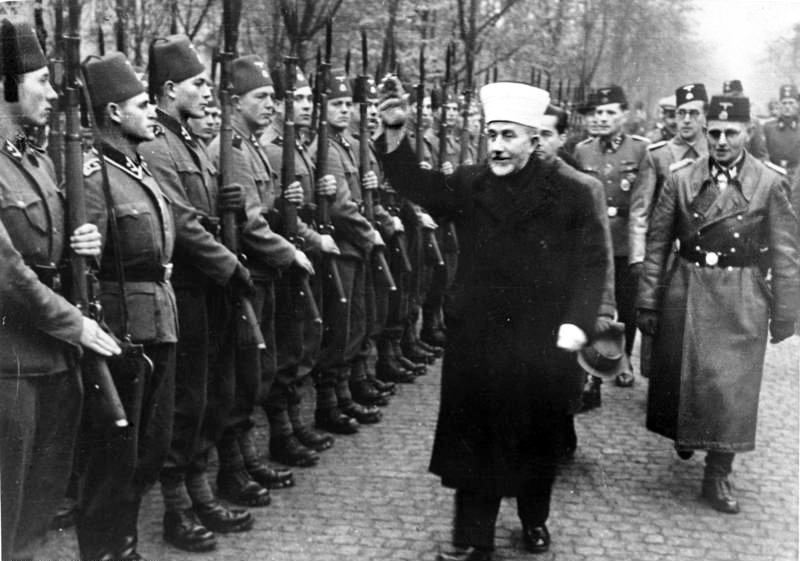 The Mufti of Jerusalem, Mohammad Amin al-Husayni, greeting members of the 13th SS Division with a Nazi salute in November 1943. The division included an estimated 1,000 Albanians from Kosovo and the Sandžak who later formed the nucleus of SS Skanderbeg Division (Source: Bundesarchiv)
The Mufti of Jerusalem, Mohammad Amin al-Husayni, greeting members of the 13th SS Division with a Nazi salute in November 1943. The division included an estimated 1,000 Albanians from Kosovo and the Sandžak who later formed the nucleus of SS Skanderbeg Division (Source: Bundesarchiv)


